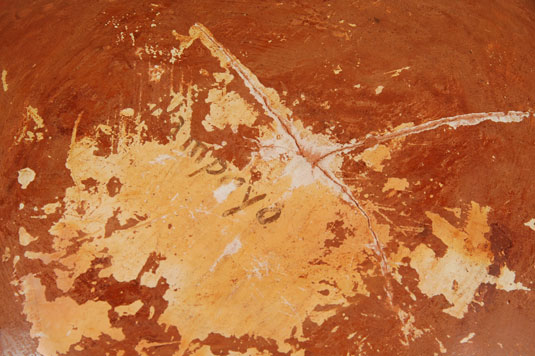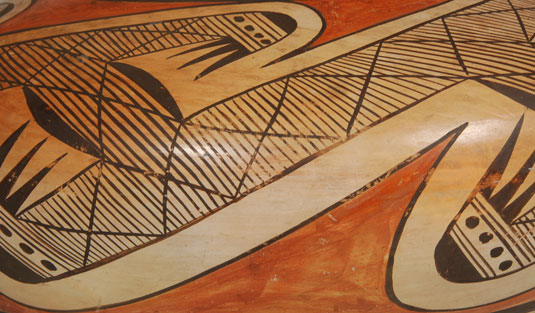Migration Pattern Polychrome Jar by Annie and Nampeyo [SOLD]
+ Add to my watchlist Forward to Friend
- Category: Historic
- Origin: Hopi Pueblo, Hopituh Shi-nu-mu
- Medium: clay, pigment
- Size: 8” tall x 13-3/4” diameter
- Item # C3530 SOLD

This is an absolute magnificent Hopi jar made by the famous Nampeyo of Hano and the design executed by her famous daughter, Annie Healing Nampeyo. It is an intriguing jar for several reasons—one of which, it is signed with the name Nampeyo, in the hand of Annie and, secondly, a red slip was applied to the base of the jar after firing, concealing the potter’s name. Presumably, the red slip was applied to hide three firing cracks on the base. It is not likely that Nampeyo or Annie did such a thing. It is more likely that a trader had it done by some other potter so that he could sell the jar without the buyer being aware of the cracks.
The pottery jar is not unstable with the cracks on the underside that have been there since the jar was made almost 100 years ago. It could be repaired should it be desired but it is not necessary. It is preferable to leave the jar in its historic state.
Dr. Edwin L. Wade, Ph.D., noted authority on the works of Nampeyo and her daughters, has prepared a letter of documentation on the jar and we present it in its entirety here:
A Migration Pattern Polychrome Jar by Annie and Nampeyo
c. 1925 – 1930
Among the many brilliant designs that Nampeyo created over the course of her long career, the two most famous are her split “Eagle Trail” and the “Migration Pattern.” As beautifully illustrated on the jar above, her interpretation of the ancient spiral or whirlwind (Ho Bo Bo) that represents planting and movement became her visualization of the migrations of the Hopi people in search of the Center or Promised Land of harmony.
The recurved serially repeated S-fret or “migration pattern” was an original adaptation by Nampeyo from similar designs common to prehistoric Black-on-white ceramics. By the turn of the 20th century, this feather motif was already common to the interior of her bowls and she had modified it into various forms now romantically referred to as “spider design,” “batwings,” and “wingtips.”
Both Nampeyo and her eldest daughter Annie (1884-1968) favored the composition. Contrary to Kramer’s assertion that Nampeyo rarely painted the complete migration design on her jars, showing an impatience to embellish the rigid pattern, a number of documented pieces by Nampeyo exist in which she excelled in its full execution. The supposed “rigid pattern” of the “migration” only became so after succeeding generations of Nampeyo’s relatives exhausted the composition, but during the first half of the 20th century it was a dynamic visual form requiring the consummate skills of an impresario.
The sculptural form of the vessel is a tour de force, dominated by a bulbous midbody pushing itself outward as if it were a bubble about to burst. This is perfectly complemented by the recurve of the concave neck, and together the two elements create a gentle undulating reversed S. All these qualities point to Nampeyo as the potter.
The painted composition is perfectly aligned with the vessel’s shape, emphasizing precise line work and expertly executed negative spaces. This is Annie at her best. The signature of Nampeyo on the jar’s bottom is in Annie’s script, dating the piece to the late 1920s or early 30s. By this time Nampeyo’s eyesight had failed, rendering her incapable of such fine painting. The intelligence and sensitive genius of her hands, however, never failed the potter.
An interesting feature somewhat unique to this vessel is that, after firing, a secondary red slip was rubbed over the vessel. I have only seen this once before, and, as with this jar, the olla had fire cracks upon its base, which had been cosmetically obscured. It’s impossible to say whether the artists or a trader applied the slip. Regardless, however, it did not mar the stunning visual quality of the object and in some way enhanced the patination of the surface. It’s hard to mess up a Nampeyo, she was just that good.
Edwin L. Wade
Condition: very good condition with firing cracks on underside as described in above text
Provenance: a handwritten letter states: “James Merritt Johnson was a temporary BIA teacher 1934-1937. He taught at the Hopi High School, Oraibi, Arizona. Jim bought this Nampeyo bowl for his mother…when he received his first check in 1934. The bowl is not signed. Many early pieces were not. It was purchased from Lorenzo Hubbell Jr., trader, at the Oraibi Hubble Post.” The jar has passed down through the family.
Recommended Reading: Canvas of Clay: Seven Centuries of Hopi Ceramic Art by Wade and Cooke

- Category: Historic
- Origin: Hopi Pueblo, Hopituh Shi-nu-mu
- Medium: clay, pigment
- Size: 8” tall x 13-3/4” diameter
- Item # C3530 SOLD



